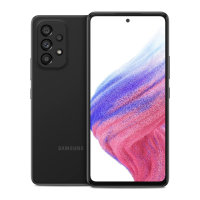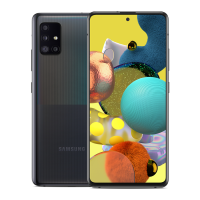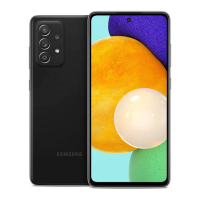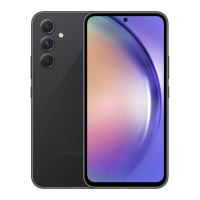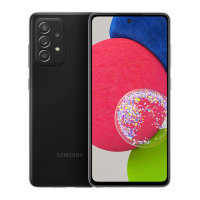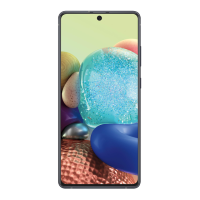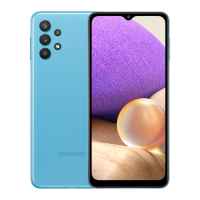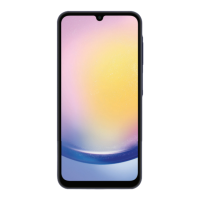Do you have a question about the Samsung Galaxy A53 5G and is the answer not in the manual?
Instructions on how to charge the battery of your Galaxy device using USB-C chargers.
Guide on how to power on, power off, and restart your Galaxy device using the Side key.
Methods for transferring data wirelessly or via USB cable from an old phone to a new Galaxy device.
Setting up and customizing screen lock features like Pattern, PIN, or Password for device security.
Steps to set up your voicemail service by accessing the Phone app and following the tutorial.
Learn about different ways to navigate your phone using touch screen gestures like Tap, Drag, Swipe, and Touch.
Guide to typing text using the on-screen keyboard, including toolbar features and customization options.
Instructions on making and answering calls using the Phone app, including call log and blocking features.
How to use Multi window split screen view to open two apps simultaneously on your device.
Create an App pair for simultaneous app usage and manage shortcuts from the Apps Edge panel.
Details on charging compatible Samsung devices using Wireless PowerShare.
How to add, remove, and change the default language on your phone.
Activating and using Emergency mode for calls, flashlight, alarms, and location sharing.
Remap the Side key to open Bixby or perform other actions like launching apps.
Adjust the order of buttons on the Navigation bar or use Swipe gestures for navigation.
Set screen time goals, use app timers, and manage Bedtime or Focus modes.
Restrict child's app usage and set limits through Google's Family Link app.
Turn Always On Display on or off and adjust its display options and settings.
Customize Home screens by adding, removing, or changing the order of screens and creating folders.
Customize font size, style, color settings, and screen brightness for better viewing.
Manually turn on Dark mode or Night mode, or set a schedule for automatic activation.
Control sound modes, vibrations, ringtones, and notification sounds for alerts.
Customize Lock screen notification settings, snooze notifications, and manage emergency alerts.
View, block, and customize notifications for individual apps.
Choose from various shooting modes like Single take, Photo, Video, Pro, and more.
Configure camera settings including intelligent features, pictures, selfies, and videos.
Instructions for filming, editing, and sharing 8K videos using your Galaxy phone.
Browse, search, and edit photos and videos using various tools within the Gallery app.
Steps to delete photos and videos from Gallery, including permanent deletion from Trash.
Methods for taking screenshots using button combinations, palm swipe, voice, or S Pen.
Record your screen, access settings, and adjust video quality and sound options.
Send images and videos directly to compatible devices or share via apps like Instagram.
Organize photos and videos by creating albums to group similar images together.
Use basic/scientific math functions, unit converter, and history features in the Calculator app.
Connect to online accounts, manage calendars, and set alert styles for events.
Set alarms, use World clock, Time zone converter, Stopwatch, and Timer features.
Add, edit, share, and set favorite contacts, manage your contact list.
Customize messages app appearance, font size, schedule messages, and manage conversations.
Manage files on your device, including moving, copying, and deleting files to storage.
Basic navigation, changing home page, using bookmarks, and managing tabs in Samsung Internet.
Download, uninstall, and reinstall apps and themes from the Galaxy Store.
Configure Game Launcher, tune device performance, and change sound settings for games.
Explore Augmented Reality features like AR Emoji Camera, AR Doodle, and Deco Pic.
Utilize Bixby as a virtual assistant for reminders, information, and task execution.
Access, create, and customize Bixby Routines for automating tasks and personalizing experience.
Connect your Galaxy watch or other wearables to your phone for various benefits.
Download and apply themes, icons, and wallpapers to personalize your device's appearance.
Access specs, features, support, diagnostics, and engaging articles for your Samsung experience.
Create a secure, encrypted space on your phone to keep personal information private.
Track daily activities, meals, measure heart rate, and consult with a doctor.
Organize notes with categories, search, lock notes, and use handwriting functions.
Use biometric data for secure sign-in to apps and websites.
Set up SmartThings to organize and control smart devices, rooms, and scenes.
Seamlessly transfer content from old phones to new Galaxy devices via wireless or USB.
Manage payment cards, membership cards, digital keys, and health passes in a digital wallet.
Access news, articles, and podcasts; customize news topics and podcasts.
Donate to global goals by watching ads or using your own funds.
Watch free live TV channels and on-demand shows and movies on Galaxy devices.
Browse the internet, manage tabs, bookmarks, and address bar data.
Open, view, rename, and share files saved to your Google Drive cloud account.
Make video calls with friends and family using the Meet app.
Send and receive email with Google’s web-based email service.
Find content online using a search engine and personalize your feed.
Make purchases with your Android phone at participating stores and in mobile apps.
Watch movies and TV shows purchased from Google Play or saved on your device.
Get directions and location-based information using Google Maps.
Store and back up photos and videos automatically to your Google Account.
Use Google's text messaging app with chat features for high-quality picture and video sharing.
Watch and upload YouTube videos directly from your device.
Download apps, manage installed apps, and reinstall paid apps and themes.
Access email, calendar, contacts, and tasks in Outlook; sync content from multiple accounts.
Connect and network with professionals, create profiles, and view company updates.
Use Word, Excel, and PowerPoint apps to format and present documents.
Store and share photos, videos, documents, and more in your free online OneDrive account.
Transfer content between PC and phone, use mobile apps on PC.
Manage Airplane mode, Mobile hotspot, VPN, Private DNS, Ethernet, and printer connections.
Connect to Wi-Fi networks, manage saved networks, and configure advanced Wi-Fi settings.
Manage your physical SIM and eSIM, activate or disable connections, and set the primary SIM.
Pair devices, rename, unpair, and use advanced Bluetooth options like Sync and Music Share.
Use NFC technology for contactless payments and select your default payment app.
Configure mobile network and data usage, manage roaming, and check signal strength.
Monitor mobile and Wi-Fi data usage, customize warnings, and manage data saver.
Use Samsung Apps Continuity across devices and manage media control.
Update phone software, set up Samsung Pass, and manage Google Play Protect.
Dictate app permissions and customize advertising content in apps.
Set up basic phone lock screen and biometric security like Face recognition.
Set up and use facial recognition for unlocking your phone and verifying identity.
Find fingerprint scanner location and set up fingerprint security.
Register fingerprint data for secure sign-in and use Autofill service.
Turn on remote controls, remote unlock, and set up a Guardian for your device.
Add Samsung, Google, or email accounts to sync data and access services.
Access and customize settings for synced accounts on your phone or tablet.
Steps to easily remove Samsung, Google, or email accounts from your device.
Back up and restore data using Samsung Cloud, Google Drive, or microSD card.
Adjust Google Services settings for ads, autofill, backup, and privacy preferences.
Create, sign in, and manage your Samsung account on phone, tablet, or computer.
Transfer media and apps to microSD cards and manage storage.
Perform software updates to keep your phone running smoothly.
Improve device performance by identifying apps using excessive battery and clearing memory.
Tips for charging your device's battery properly for best results.
Clear out unnecessary files from your storage to improve performance.
Free up memory by stopping background apps and rebooting your device.
Set time and date automatically or manually, and use 24-hour format.
View IMEI, serial number, and model number directly on the phone or tablet.
Manage battery usage, screen timeout, accidental touch protection, and adaptive brightness.
Set custom controls, use Assistant menu, Voice Access, and manage call answering options.
Explore features like TalkBack, Visibility enhancements, Hearing enhancements, and Advanced settings.
Enable, navigate, and adjust settings for the TalkBack voice assistant.
Improve screen readability with display modes, high contrast, color filters, and screen zoom.
Optimize sound quality with hearing aid support, amplify ambient sound, or mute sounds.
Create direct access for features, customize notifications, and manage advanced functions.
View and manage installed accessibility apps and services.
Check DeX compatibility and use DeX with a cable, wirelessly, or on PC.
Connect your phone to your car for audio playback and hands-free control.
Access the SmartThings app from your car's dashboard using Android Auto.
Organize accounts by setting up and using Dual Messenger for apps.
| Screen shape | Flat |
|---|---|
| Pixel density | 407 ppi |
| Display diagonal | 6.5 \ |
| Touchscreen type | Capacitive |
| Display brightness | 420 cd/m² |
| Display resolution | 2400 x 1080 pixels |
| Native aspect ratio | 20:9 |
| Maximum refresh rate | 120 Hz |
| Gorilla Glass version | Gorilla Glass 5 |
| Rounded display corners | Yes |
| Contrast ratio (typical) | 1000000:1 |
| Display number of colors | 16 million colors |
| Processor cores | 8 |
| Processor family | Samsung Exynos |
| Processor frequency | - GHz |
| Processor boost frequency | 2.4 GHz |
| RAM capacity | 8 GB |
| Compatible memory cards | MicroSD (TransFlash) |
| Maximum memory card size | 1000 GB |
| Internal storage capacity | 128 GB |
| Flash type | LED |
| Rear camera type | Quad camera |
| Front camera type | Single camera |
| Image stabilizer type | Optical Image Stabilization (OIS) |
| Video recording modes | 2160p |
| Rear camera aperture number | 1.8 |
| Resolution at capture speed | - |
| Rear camera resolution (numeric) | 64 MP |
| Front camera resolution (numeric) | 32 MP |
| Third rear camera aperture number | 2.4 |
| Second rear camera aperture number | 2.2 |
| Third rear camera resolution (numeric) | 5 MP |
| Second rear camera resolution (numeric) | 12 MP |
| 4G standard | LTE-TDD & LTE-FDD |
| 3G standards | WCDMA |
| SIM card type | NanoSIM |
| Wi-Fi standards | 802.11a, 802.11b, 802.11g, Wi-Fi 4 (802.11n), Wi-Fi 5 (802.11ac) |
| Bluetooth version | 5.1 |
| 4G bands supported | 700, 800, 850, 900, 1500, 1800, 1900, 2100, 2300, 2500, 2600 MHz |
| 5G bands supported | 700, 800, 900, 1800, 2100, 2600, 3500 MHz |
| Bluetooth profiles | A2DP |
| SIM card capability | Hybrid Dual SIM |
| Mobile network generation | 5G |
| Subscription type | No subscription |
| USB version | 2.0 |
| USB connector type | USB Type-C |
| Multimedia Messaging Service (MMS) | Multimedia Messaging Service (MMS) is a standard way to send messages that include multimedia content to and from a mobile phone over a cellular network |
| Color name | Awesome Black |
| Form factor | Bar |
| Product color | Black |
| Housing material | Polycarbonate (PC) |
| Protection features | Waterproof |
| International Protection (IP) code | IP67 |
| Graphics card | Mali-G68 MP4 |
| Speakers | stereo |
| Audio system | Dolby Atmos |
| Platform | Android |
| Virtual assistant | Samsung Bixby |
| App distribution platform | Google Play |
| Operating system installed | Android 12 |
| Talk time (3G) | - h |
| Battery capacity | 5000 mAh |
| Browsing time (4G) | 16 h |
| Wireless audio playback time | 60 h |
| Wireless video playback time | 18 h |
| Body SAR (EU) | 1.597 W/kg |
| Head SAR (EU) | 0.885 W/kg |
| Depth | 8.1 mm |
|---|---|
| Width | 74.8 mm |
| Height | 159.6 mm |
| Weight | 189 g |
